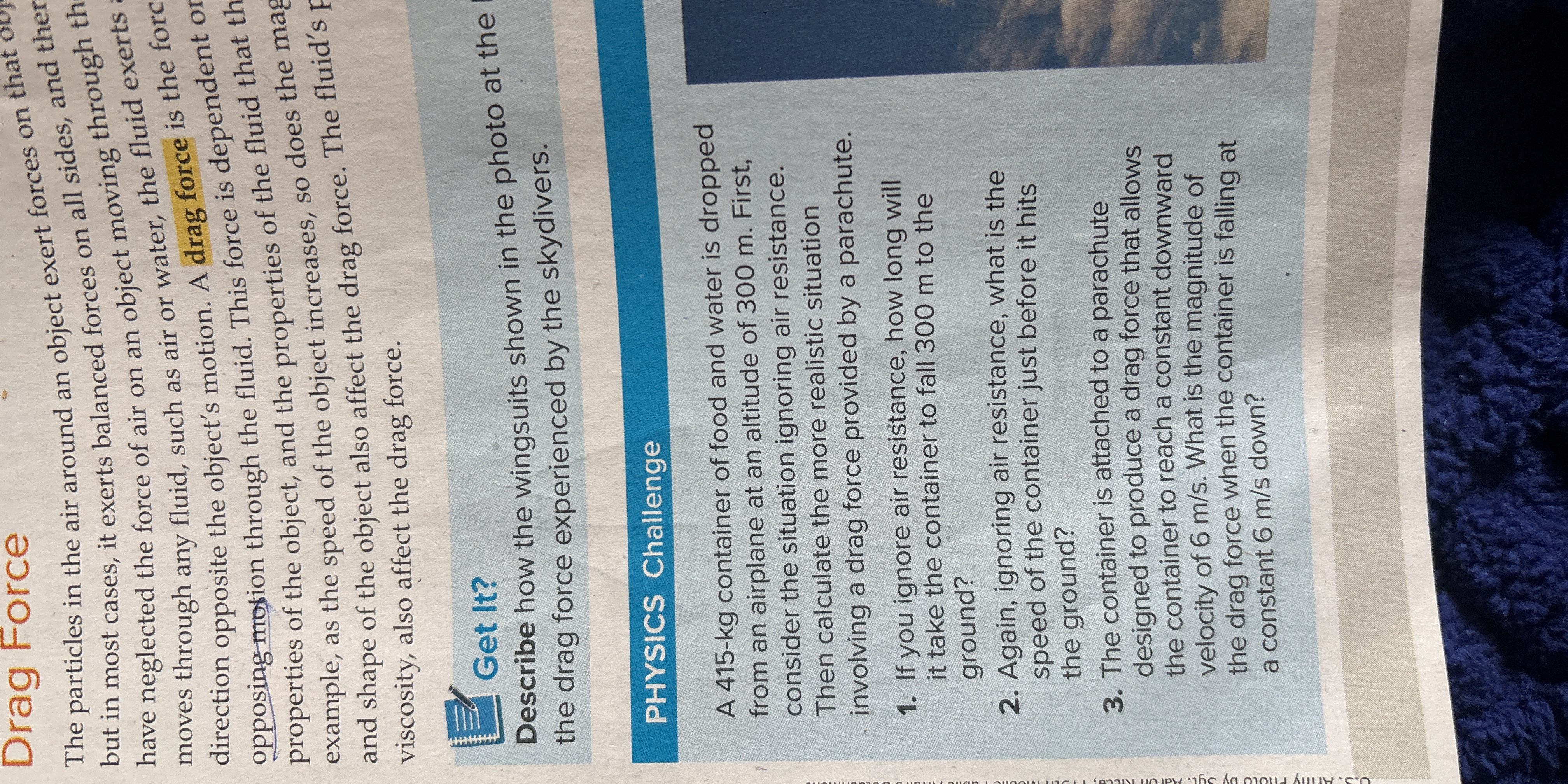A 415 kg container of food and water is dropped from an airplane at an altitude of 300 m. Consider the situation ignoring air resistance. Calculate how long it will take the contai... A 415 kg container of food and water is dropped from an airplane at an altitude of 300 m. Consider the situation ignoring air resistance. Calculate how long it will take the container to fall 300 m to the ground. Next, if the container is attached to a parachute designed to produce a drag force that allows the container to reach a constant downward velocity of 6 m/s, what is the magnitude of the drag force when the container is falling at a constant 6 m/s down?

Understand the Problem
The question is asking to solve a physics problem involving drag force and air resistance for a container of food and water dropped from an airplane. It involves calculating how long it takes for the container to fall 300 m without air resistance, and then determining the drag force when the container is falling at a constant speed of 6 m/s.
Answer
The time to fall is approximately $7.81 \, \text{s}$ and the drag force is $4076.15 \, \text{N}$.
Answer for screen readers
-
The time taken to fall 300 m without air resistance is approximately $7.81 , \text{s}$.
-
The drag force when the container is falling at a constant speed of $6 , \text{m/s}$ is approximately $4076.15 , \text{N}$.
Steps to Solve
- Calculate Time to Fall Without Air Resistance
To find the time it takes to fall 300 m without air resistance, we can use the equation for free fall:
$$ d = \frac{1}{2} g t^2 $$
Here, ( d ) is the distance (300 m), ( g ) is the acceleration due to gravity (approximately ( 9.81 , \text{m/s}^2 )), and ( t ) is the time in seconds. Rearranging for ( t ) gives:
$$ t = \sqrt{\frac{2d}{g}} $$
Substituting the values:
$$ t = \sqrt{\frac{2 \times 300 , \text{m}}{9.81 , \text{m/s}^2}} $$
- Determine Time Calculation
Now we calculate this value:
$$ t = \sqrt{\frac{600}{9.81}} \approx \sqrt{61.15} \approx 7.81 , \text{s} $$
So, it takes approximately 7.81 seconds for the container to fall 300 m without air resistance.
- Calculate the Drag Force at Constant Velocity
When the container is falling at a constant speed of 6 m/s, the drag force equals the weight of the container. The weight can be calculated using:
$$ F_g = mg $$
Where ( m ) is the mass (415 kg) and ( g ) is again the acceleration due to gravity:
$$ F_g = 415 , \text{kg} \times 9.81 , \text{m/s}^2 $$
Thus, we compute:
$$ F_g \approx 4076.15 , \text{N} $$
Since the drag force equals the gravitational force at constant velocity:
$$ F_d = F_g $$
Therefore, the drag force is approximately 4076.15 N.
-
The time taken to fall 300 m without air resistance is approximately $7.81 , \text{s}$.
-
The drag force when the container is falling at a constant speed of $6 , \text{m/s}$ is approximately $4076.15 , \text{N}$.
More Information
These calculations illustrate how the forces of gravity and drag work together during free fall. When an object falls without air resistance, it accelerates under the influence of gravity. However, once the object reaches a specific speed (terminal velocity), the drag force counteracts its weight, resulting in a constant speed.
Tips
- Neglecting Units: Always include units during calculations to avoid confusion.
- Ignoring Air Resistance Problem: Sometimes, it's easy to forget that air resistance affects acceleration and speed in real-life scenarios.
- Miscalculation of Gravity: Make sure to use the correct value of ( g = 9.81 , \text{m/s}^2 ) unless specified otherwise.
AI-generated content may contain errors. Please verify critical information